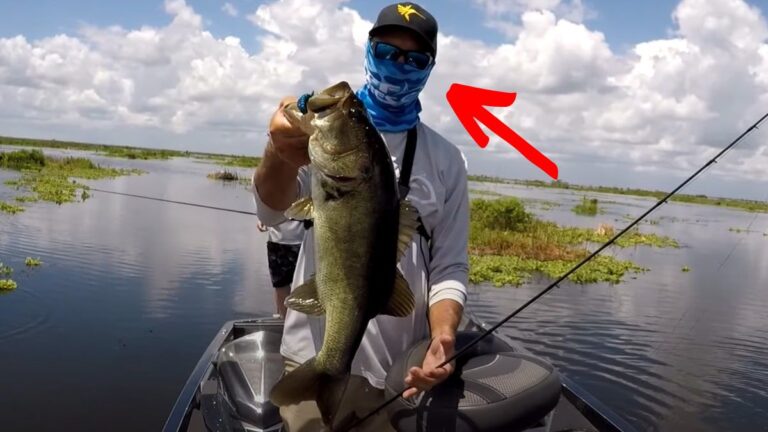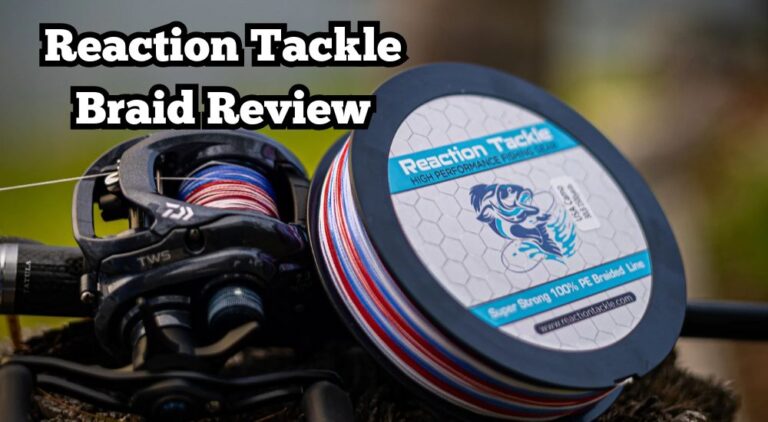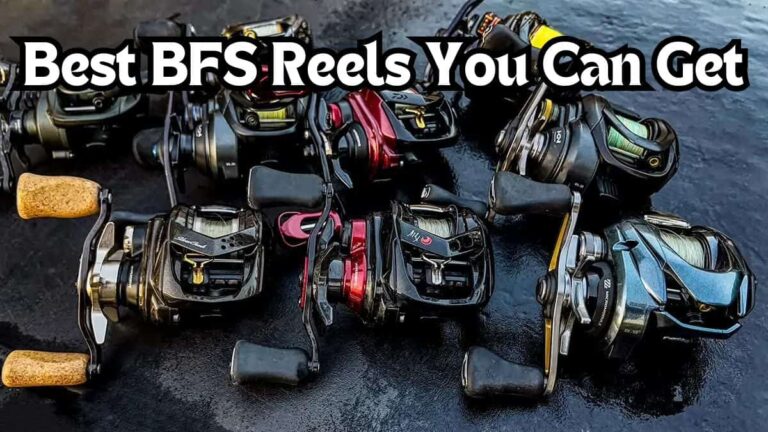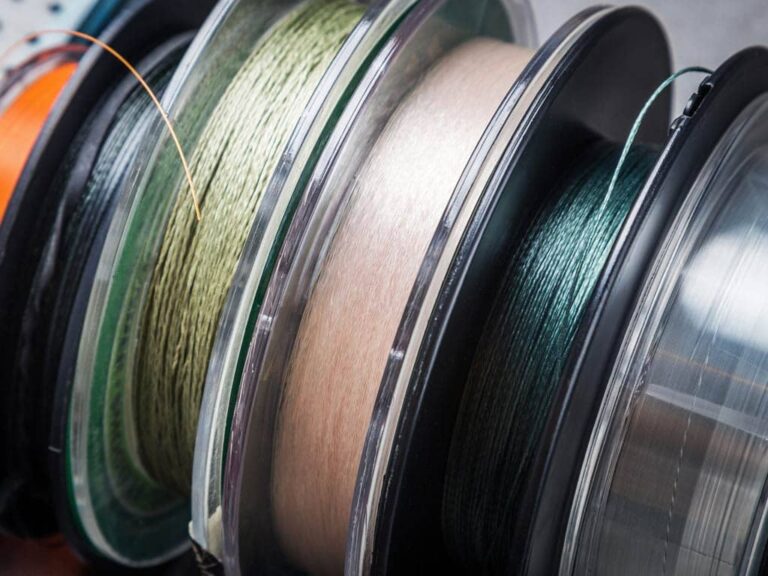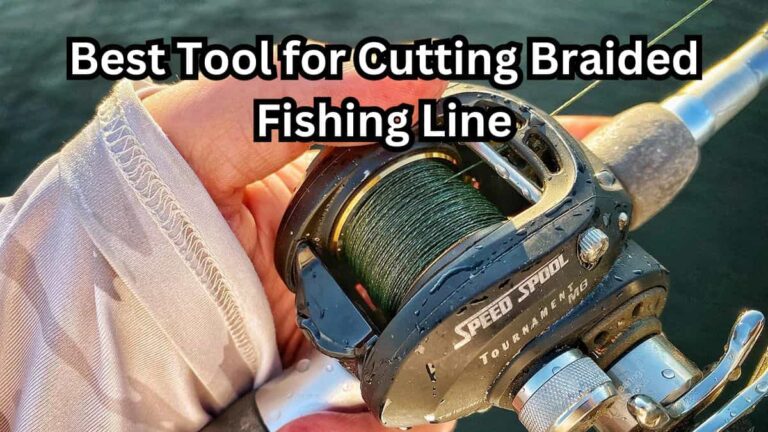Baitcaster vs Spinning Reel: Guide to Fishing Reels
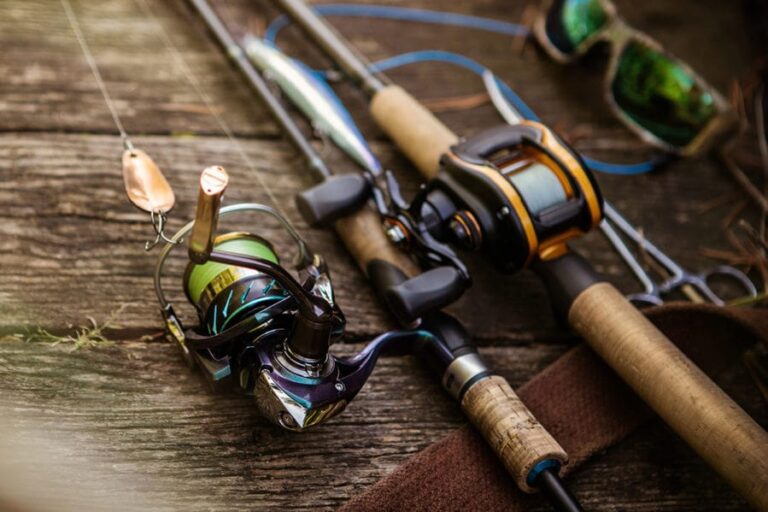
Hey there, fellow anglers! In this article, we’re going to unravel the mystery behind two popular contenders: the Baitcaster and the Spinning Reel.
Baitcaster or Spinning Reel? That’s the question we’ll tackle head-on, weighing the pros and cons of each.
If you’ve always wondered why some anglers swear by Baitcasters while others stick to their trusty Spinning Reels, get ready to find out!
So, grab your fishing hat and let’s embark on this exciting journey of comparing Baitcaster and Spinning Reels – the ultimate guide to helping you reel in that big catch with confidence!
Baitcaster vs Spinning Reel
Choosing the right fishing reel is crucial for a successful and enjoyable fishing experience.
It ensures optimal performance, efficiency, and caters to your skill level. The right reel also matches your target species and fishing techniques, making it a worthwhile investment that brings joy and satisfaction on every fishing trip.
Don’t overlook the importance of selecting the perfect reel for your angling needs – it can make all the difference between a memorable catch and a missed opportunity!
Baitcaster
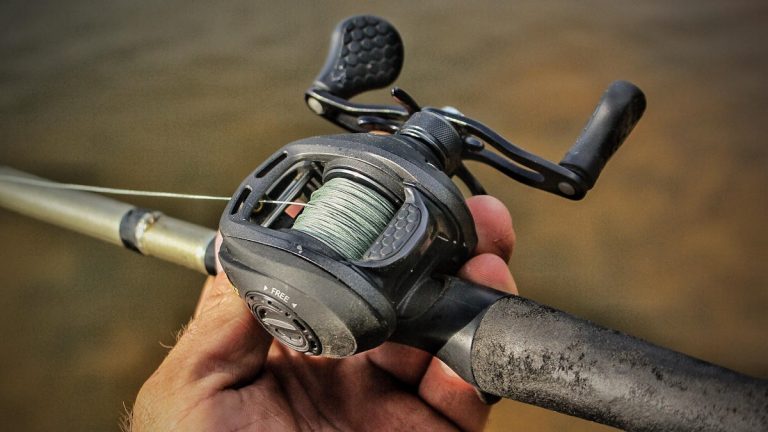
Baitcaster reels are specialized fishing reels known for their precise casting control and ability to handle heavier lures and lines.
They feature a revolving spool that offers greater accuracy and distance during casting.
While favored by experienced anglers for targeted casts in specific fishing scenarios, they have a steeper learning curve, making them more suitable for seasoned fishermen.
Baitcaster reels come in different gear ratios for varying retrieval speeds. Overall, they’re an excellent choice for those seeking accuracy and power in their fishing endeavors.
Benefits of Baitcaster Reels
- Precise Casting Control: Offers accurate placement of lures for targeted casts.
- Handling Heavier Lures and Lines: Ideal for larger fish species and robust tackle.
- Increased Power and Torque: Provides strength during retrieval and fighting fish.
- Versatility in Fishing Techniques: Adapts well to various angling styles.
- Reduced Line Twist: Minimizes tangles and ensures smooth line flow.
- Durability and Longevity: Built with sturdy materials for lasting performance.
- Adjustable Braking Systems: Reduces backlash risk and fine-tunes casting.
- Enhanced Sensitivity: Detects subtle bites and changes in the environment effectively.
Struggles of Baitcaster Reels
- Steep Learning Curve: Takes time and practice to master casting techniques and avoid backlash.
- Potential Backlash Issues: Inexperienced users may experience tangled lines during casting.
- Less Beginner-Friendly: Not the best choice for novice anglers.
- Cost: High-quality baitcasters can be more expensive than basic spinning reels.
- Maintenance Complexity: Requires intricate maintenance for optimal performance.
- Not Ideal for Light Lures: Less finesse when casting very light lures.
- Casting Distance Limitation: May not match the maximum casting distance of high-end spinning reels.
- Reduced Line Capacity: Holds less line compared to spinning reels, impacting certain fishing situations.
Dealing with Backlash
Backlash can be a frustrating issue when using a baitcaster reel, but with a few techniques, you can minimize its occurrence and effectively manage it when it happens:
- Adjust the Brakes: Most baitcasters come with adjustable braking systems. Start by setting the brakes higher if you’re a beginner or using a heavier lure. As you gain confidence and skill, gradually reduce the braking force to increase casting distance.
- Thumb Control: Your thumb is your best friend when casting with a baitcaster. Apply light pressure on the spool with your thumb during the cast to control the speed and prevent overruns.
- Smooth Casting Motion: Make sure to cast smoothly and avoid abrupt motions that can cause the line to tangle. Practice a fluid casting motion to improve accuracy and reduce backlash.
- Tension Adjustment: Adjust the spool tension knob located on the side of the reel. It should be tight enough to prevent the spool from freely spinning but loose enough for smooth casting.
- Practice, Practice, Practice: Backlash is common, especially when learning to use a baitcaster. Don’t get discouraged. Spend time practicing in an open area, gradually increasing your casting skills.
- Remove Tangles Carefully: If backlash occurs, stay patient. Gently remove the tangled line by pulling it from both ends, ensuring not to make the situation worse.
- Use Heavier Lines: Thicker lines are less prone to tangling during casting. Consider using a slightly heavier line if backlash is a persistent problem.
- Learn from Others: Seek advice and tips from experienced anglers or watch online tutorials to improve your baitcasting skills.
By implementing these strategies and remaining patient, you can effectively deal with backlash and enhance your overall baitcasting experience.
Remember, practice makes perfect, and with time, you’ll be casting like a pro without worrying about pesky backlashes.
Spinning Reel

Spinning reels are the easy-to-use favorites of many anglers. Unlike baitcasters, they have a fixed spool, making casting a breeze.
They’re versatile, suitable for various fishing techniques, and great for beginners. Spinning reels offer smooth line management and are budget-friendly.
While not as powerful as baitcasters, they’re a go-to choice for enjoyable fishing experiences!
Benefits of Spinning Reels
- Ease of Use: Spinning reels are incredibly beginner-friendly, making them perfect for newcomers to fishing. Casting is simple, requiring minimal effort to get started.
- Versatility: These reels are highly versatile, accommodating various fishing techniques. Whether you’re casting lures, using live bait, or even ice fishing, a spinning reel can handle it all.
- Smooth Line Management: Spinning reels provide smooth line release, reducing the likelihood of tangles and backlashes. This ensures a hassle-free fishing experience and more time spent with your line in the water.
- Affordability: Compared to other types of reels, spinning reels are generally more affordable. You can find high-quality spinning reels that fit any budget.
- Less Line Twisting: With spinning reels, the line spools off the spool in a circular motion, reducing line twist and tangling. This leads to better overall line performance and less maintenance.
- No Casting Backlash: Since there’s no revolving spool, beginners are free from the frustration of casting backlash. This encourages a positive fishing experience from the start.
- Easy Maintenance: Spinning reels are easy to maintain, with fewer moving parts and straightforward cleaning procedures.
- Suitable for Light Lures: Spinning reels excel at casting lighter lures, making them a great choice for finesse fishing and targeting smaller fish.
Struggles of Spinning Reels
- Reduced Casting Accuracy: Compared to baitcaster reels, spinning reels offer less casting accuracy and control, especially in windy conditions. Long-distance and pinpoint casting might be more challenging.
- Limited Casting Distance: Spinning reels may have limitations when it comes to casting distance, especially when using heavier lures or tackling larger fish.
- Line Twist: Although spinning reels minimize line twist compared to baitcasters, it can still occur, especially with lightweight lures or during extended use.
- Lower Power for Heavy Fishing: Spinning reels might not have the same power and torque as baitcasters, making them less suitable for heavy-duty fishing or fighting hard-fighting fish.
- Learning Curve for Line Management: Beginners may initially struggle with line management, as loops and tangles can happen if not handled properly.
- Line Capacity Limitation: Spinning reels generally have smaller line capacities than baitcasters, which could be a limitation in certain fishing situations.
- Possible Line Slippage: In some cases, the line may slip or dig into the spool during heavy use, potentially affecting casting performance.
Also Read: Best Fishing Line for Spinning Reels
Key Differences of Baitcasters and Spinning Reels
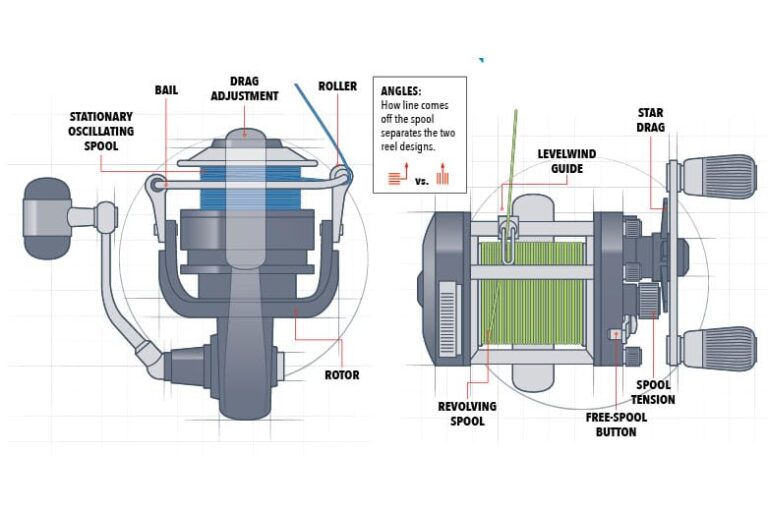
The battle between baitcaster and spinning reels has been a topic of discussion among anglers for ages. Let’s dive into the key differences between these two types of fishing reels:
- Spool Orientation:
- Baitcaster: Baitcaster reels have a revolving spool that rotates during casting.
- Spinning: Spinning reels have a fixed spool positioned parallel to the rod.
- Casting Mechanism:
- Baitcaster: Baitcasters offer precise casting control, ideal for accuracy and targeted casts.
- Spinning: Spinning reels provide easier casting, making them beginner-friendly and more forgiving with fewer backlashes.
- Casting Accuracy:
- Baitcaster: Baitcasters excel in casting accuracy, allowing anglers to hit specific spots with ease.
- Spinning: Spinning reels may not offer the same pinpoint accuracy as baitcasters, especially in adverse conditions.
- Casting Distance:
- Baitcaster: Baitcasters are known for their casting distance, making them suitable for long-range casting.
- Spinning: Spinning reels have limitations in casting distance, particularly with heavier lures.
- Line Management:
- Baitcaster: Baitcasters have a steeper learning curve for line management, and backlash can be a challenge for beginners.
- Spinning: Spinning reels offer smoother line release, reducing the likelihood of tangles and backlashes.
- Versatility:
- Baitcaster: Baitcasters are more specialized and excel in specific fishing scenarios.
- Spinning: Spinning reels are versatile, accommodating various fishing techniques and lure types.
- Suitable for Light Lures:
- Baitcaster: Baitcasters may not be as suitable for casting very light lures as spinning reels are.
- Power and Torque:
- Baitcaster: Baitcasters generally offer more power and torque, making them better for heavy-duty fishing and fighting big fish.
- Spinning: Spinning reels may not have the same power as baitcasters, but they’re more forgiving for finesse fishing.
- Skill Level:
- Baitcaster: Baitcasters are better suited for experienced anglers who can master their casting technique.
- Spinning: Spinning reels are beginner-friendly and great for anglers of all skill levels.
Understanding these key differences can help you choose the right reel for your specific fishing needs and preferences.
Whether you prioritize casting accuracy, power, or ease of use, both baitcaster and spinning reels have their unique strengths to offer on your fishing adventures.
Choosing the Right Reel for You
When it comes to selecting the perfect fishing reel, one size doesn’t fit all. Choosing the right reel depends on various factors, so let’s dive into some essential considerations:
- Skill Level and Experience: Consider your level of fishing expertise. If you’re a beginner, a spinning reel might be the best option due to its ease of use and forgiving nature. On the other hand, if you’re an experienced angler looking for precision and control, a baitcaster could be your ideal match.
- Target Species and Fishing Techniques: Think about the type of fish you plan to catch and the fishing techniques you’ll employ. For heavy-duty fishing or going after large fish, a baitcaster’s power and torque might be preferable. If you enjoy finesse fishing or targeting smaller species, a spinning reel’s versatility could be more suitable.
- Casting Distance and Accuracy: Consider the casting distance and accuracy you need for your fishing style. Baitcasters are known for their long-range casting and precise control, while spinning reels offer ease of casting and better forgiveness for beginners.
- Lure and Line Weight: Take into account the weight of the lures and lines you intend to use. Baitcasters handle heavier baits and lines better, while spinning reels excel with lighter lures.
- Fishing Environment: Assess the fishing environments you’ll encounter. Baitcasters may be more suitable for fishing in areas with heavy cover, while spinning reels can handle various fishing scenarios, including shore fishing and ice fishing.
- Comfort and Preference: Handle both types of reels to see which one feels more comfortable in your hands. Personal preference plays a significant role in the enjoyment of your fishing experience.
- Budget: Consider your budget when choosing a reel. Spinning reels are generally more budget-friendly, but high-quality baitcasters are worth the investment for experienced anglers seeking advanced performance.
- Versatility: If you enjoy experimenting with different fishing techniques, a spinning reel’s versatility might be more appealing. However, if you have a specific fishing style or target species in mind, a baitcaster could be your go-to choice.
Whether you go for the finesse and ease of a spinning reel or the accuracy and power of a baitcaster, the right reel will enhance your fishing adventures and help you reel in more memories with each catch.
Reeling this In
In conclusion, whether you opt for the versatile spinning reel or the precise baitcaster, the right choice depends on your fishing style and preferences.
Both reels offer unique advantages, so practice and experience will help you make the most of your fishing adventures.
Remember, fishing is about more than just catching fish; it’s about the joy, memories, and connection with nature.
So, head out to the waters with confidence, enjoy the thrill of the chase, and may every fishing trip bring you unforgettable moments and tight lines! Happy fishing, everyone!

